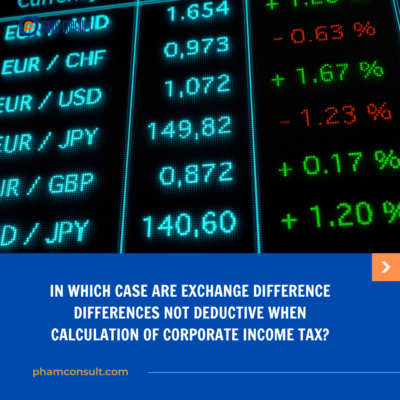Exchange rate differences are recorded through which account? In what cases is exchange rate difference loss not deductible when calculating corporate income tax? Regulations on types of exchange rates used in accounting? Through today’s article, let’s learn about this issue with Pham Consult!

What is the exchange rate?
An exchange rate is the ratio of the value of one country’s currency to another country’s currency. For example, the exchange rate between USD (the currency of the United States) and EUR (the currency of the EU eurozone) is 1.20 USD/EUR, which means that one US dollar can exchangeable for 1.20 Euro.
Exchange rates are often used to calculate the value of international trade transactions, foreign investments, and other financial activities.
For example, if a US company wants to buy some goods from a company in Japan, they will have to pay in yen. The exchange rate will determine the amount of US dollars the US company will have to pay to buy those goods.
Exchange rates are determined through foreign exchange markets, where rates are determined based on the balance between supply and demand of currencies. These exchange rates often change continuously over time and can affect many aspects of the economy and people’s lives.
Exchange rate differences are recorded through which account?
Exchange rate differences are specified in Article 69 of Circular 200/2014/TT-BTC as follows:
Account 413 – Exchange rate difference
1. General regulations on exchange rates and exchange rate differences
1.1. Exchange rate differences are differences arising from the actual exchange or conversion of the same amount of foreign currency into the accounting currency at different exchange rates. Exchange rate differences mainly arise in the following cases:
– Actual purchase, sale, exchange, and payment of economic transactions arising in foreign currency during the period;
– Re-evaluate monetary items denominated in foreign currencies at the time of preparing the financial statements;
– Convert financial statements prepared in foreign currency to Vietnam Dong.
…
Thus, it can be seen that exchange rate differences are recorded through account 413.
Accordingly, exchange rate differences are explained as differences arising from the actual exchange or conversion of the same amount of foreign currency into the accounting currency at different exchange rates.
In what cases is exchange rate difference loss not deductible when calculating corporate income tax?
According to the provisions of Point 2.21, Clause 2, Article 6 of Circular 78/2014/TT-BTC (amended by Article 4 of Circular 96/2015/TT-BTC), exchange rate difference losses cannot be deducted when calculating tax. corporate income if falling into the following cases:
– Exchange rate difference loss due to reassessment of monetary items denominated in foreign currencies at the end of the tax period includes exchange rate differences due to reassessment of year-end balances: cash, deposits, money currently in transit, receivables originating in foreign currencies (except for losses in exchange rate differences due to reassessment of debts payable originating in foreign currencies at the end of the tax period).
– During the construction investment phase to form fixed assets of a newly established enterprise that has not yet been put into operation, exchange rate differences arise when paying monetary items of foreign currency origin to make payments. Current construction investments and exchange rate differences arising when re-evaluating liabilities denominated in foreign currencies at the end of the fiscal year are reflected separately.
When the fixed assets are completed and put into use, the exchange rate difference arising during the construction investment phase (after compensating the increase and decrease difference) is gradually allocated to financial revenue or financial costs, the allocation time must not exceed 5 years from the time the project is put into operation.
– During the production and business phase, including construction investment to form fixed assets of an operating enterprise, exchange rate differences arising from transactions in foreign currencies of these items Currency denominated in foreign currency will be accounted for in financial revenue or financial expenses in the fiscal year.
– For debts receivable and loans originating in foreign currency arising during the period, the exchange rate difference included in deductible expenses is the difference between the exchange rate at the time of debt collection or collection. recover the loan at the exchange rate at the time the receivable or initial loan was recorded.
Regulations on types of exchange rates used in accounting?
The types of exchange rates used in accounting are specified in Clause 1, Article 69 of Circular 200/2014/TT-BTC as follows:
Account 413 – Exchange rate difference
1. General regulations on exchange rates and exchange rate differences
…
1.2. Types of exchange rates (hereinafter referred to as exchange rates) used in accounting
Enterprises with economic operations arising in foreign currency must record accounting books and prepare financial statements in a unified currency unit of Vietnam Dong, or the official currency unit used in accounting. maths. The conversion of foreign currency into Vietnamese Dong must be based on:
– Actual exchange rate;
– Exchange rate recorded in accounting books.
When determining tax obligations (declaration, settlement and payment of taxes), enterprises shall comply with the provisions of tax law.
…
According to this regulation, businesses with economic operations arising in foreign currency must record accounting books and prepare financial statements in a unified currency unit, Vietnam Dong, or the main currency unit. method used in accounting.
The conversion of foreign currency into Vietnamese Dong must be based on:
– Actual exchange rate;
– Exchange rate recorded in accounting books.
The types of exchange rates used in accounting are specified in Clause 1, Article 69 of Circular 200/2014/TT-BTC as follows:
Account 413 – Exchange rate difference
1. General regulations on exchange rates and exchange rate differences
…
1.2. Types of exchange rates (hereinafter referred to as exchange rates) used in accounting
Enterprises with economic operations arising in foreign currency must record accounting books and prepare financial statements in a unified currency unit of Vietnam Dong, or the official currency unit used in accounting. maths. The conversion of foreign currency into Vietnamese Dong must be based on:
– Actual exchange rate;
– Exchange rate recorded in accounting books.
When determining tax obligations (declaration, settlement and payment of taxes), enterprises shall comply with the provisions of tax law.
…
According to this regulation, businesses with economic operations arising in foreign currency must record accounting books and prepare financial statements in a unified currency unit, Vietnam Dong, or the main currency unit. method used in accounting.
The conversion of foreign currency into Vietnamese Dong must be based on:
– Actual exchange rate;
– Exchange rate recorded in accounting books.
Comments




 VI
VI